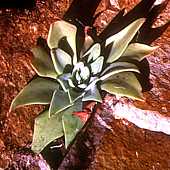Echeveria de Candolle 1828
Named for: Atanasio Echeverría y Codoy, 18th c. botanist
The genus Echeveria includes over a hundred diverse species of rosetted succulent plants from Mexico, central and S. America. Just one species, Echeveria strictiflora is native to Texas.
Rosettes may be compact and formed from thick, fleshy succulent leaves or the leaves may be thinner or scattered along the stem. Many species have smooth, waxy leaves but in others, the leaves may be quite hairy.
Cultivation:
 Many cultivars and hybrids of these popular plants are propagated in the horticultural trade. Most Echeverias are insufficiently hardy to survive a cold, wet winter, but they are often used as summer bedding plants and housed under glass for the winter where most only need dry, frost-free conditions. The large distinctive rosettes of some cultivars make attractive "feature plants". Cultivars with smaller rosettes can be used in carpet bedding. It is possible to create an impressive multi-coloured display of different Echeveria species and cultivars.
Many cultivars and hybrids of these popular plants are propagated in the horticultural trade. Most Echeverias are insufficiently hardy to survive a cold, wet winter, but they are often used as summer bedding plants and housed under glass for the winter where most only need dry, frost-free conditions. The large distinctive rosettes of some cultivars make attractive "feature plants". Cultivars with smaller rosettes can be used in carpet bedding. It is possible to create an impressive multi-coloured display of different Echeveria species and cultivars.
As with many succulent plants, a sunny position is needed to obtain an attractive compact rosettte and for the leaves of some cultivars to colour up. However, most species are happy with cool but frost-free winter conditions if kept dry. In a poor light the plant will quickly become soft and etiolated. Damp makes them prone to fungal damping off. Remove dead basal leaves from rosettes to reduce the risk of fungal attack.
The rosettes can usually be re-rooted very easily. If the stem below the rosette becomes long and unsightly, it is a simple matter to cut it off an inch or so below the rosette and re-root. Echeverias like a slightly acidic, sandy free-draining mixture and dislike lime.
Individual Echeveria leaves will root and form new plants although it will usually be quicker to obtain new plants by taking offsets as cuttings.
Cultivars with white farinose leaves should not be watered from above if growing for show. The slightest touch will mark the farina, spoiling the result of years of cultivation. Mealy bug is the main pest and can be avoided by watering with systemic insecticides containing imidacloprid.
|
 |
Echeveria agavoides Lemaire 1863
The rosettes of thick, succulent leaves grow slowly to 10 - 12 inches in diameter. Rosettes are often solitary but may produce offsets at their base or on stolons when mature. Various selected forms with coloured leaf margins or cristate growth habit are in circulation. This species has also been used to make hybrids. Undemanding but not frost hardy.
Native to rocky outcrops at high altitudes in central Mexico.
Left: Echeveria agavoides cv. "Red Edge" Walther 1972
|
 |
Echeveria cante Glass & Mendoza-Garcia 1997
The rosettes grow up to 16 in diameter with large fleshy, obovate glaucous leaves with an acute tip, sometimes tinged with purple and with a pinkish margin. The inflorescence is a cymose cluster of orange flowers.
Native to the Mexican state of Zacatecas. Although fairly new to cultivation, this species is already appearing as a feature plant in Summer bedding.
|
 |
Echeveria coccinea (Cavanilles) De Candolle 1828
Name: Latin coccineus = red, referring to red tips to the pale yellow petals.
This is the type species for the genus. Echeveria coccinea is a shrubby succulent plant growing up to 2 ft tall, with grayish stems patterned with leaf scars, supporting fleshy rosettes of oblanceolate leaves at their ends. The inrolled leaves have a green upper concave surface and a grayish convex lower surface. All parts are pubescent except for the inner flower surface. Flowers are yellow with scarlet petal tips or completely scarlet with yellowish insides.
Native to the Mexican state of Hildago. A cristate form is in circulation.
|
 |
Echeveria compressicaulis Eggli & N.P. Taylor 2002
The small rosette is distinctively-formed from very dark reddish-green to almost black obovate leaves. Stems are distinctively compressed and angled by elongated flattened leaf scars. The inflorescence is a raceme of orange bells.
Native to the Venezuelan state of state of Mérida
|
 |
Echeveria derenbergii Purpus 1921
The rosettes of glaucous leaves with reddened margins become columnar with age. The base of the column is felted with persistent old dried leaves. The inflorescence is a small cluster of upright yellow bell-like flowers.
Native to the Mexican state of Oaxaca.
|
 |
Echeveria harmsii Macbride 1931
The thick stems have a rosette of grey-green leaves with purple margins, near their growing points. Some older leaves remain distributed along the stems or older leaves may wither and drop off. The lax inflorescence has several green bracts along its length, terminating in one or two maroon flowers with yellow tips and insides.
All parts may be slightly pubescent except for inside the flowers.
Native to the Mexican state of Oaxaca. Makes a good show when in flower.
|
 |
Echeveria lauii Moran & Meyran 1993
Named for: Alfred Lau, Mexican botanist.
The slow-growing compact rosette is fomed from succulent, obovate, greyish-green leaves covered in a white farina. The inflorescence is a cluster of many orange flowers on a short flower stalk.
Native to the Mexican state of Oaxaca.
The white coating is very easily rubbed off the leaves so that growing a perfect specimen plant is a challenge. Watering should always be from below. A small plant should be potted up in a larger than necessary pot, as repotting without spoiling the white coating is virtually impossible.
|
 |
Echeveria leuchotricha Purpus 1914
Ovate blue-green leaves with dense white pubescence becoming brown near the leaf tips are arranged into loose rosettes towards the ends of the stems. The inflorescence is a short, upright spike of red flowers within glaucous blue bracts.
Native to the Mexican state of Puebla.
|
 |
Echeveria macdougallii Walther 1958 Syn. Echeveria sedoides Walther 1972
Small fleshy rosettes of oval yellow-green leaves with reddened tips are carried on the end of an upright brown stem. The inflorescence is a small cluster of orange flowers with yellow inner surfaces on the end of a long stem with oval green sepals.
Native to the Mexican state of Oaxaca.
|
 |
Echeveria pilosa J.A. Purpus 1917
Short stems support rosettes of spatulate to obovate green leaves with mucronate tips and a coating of fine white hairs. Margins and tops of the leaves may be reddened or brownish. The inflorescence is a cluster of orange red bells at the end of a leafy flower stalk.
Native to Mexico.
|
 |
Echeveria prolifica Moran & Meyrán 1978
The rosettes are formed from fleshy, glaucous ovate leaves with a pointed tip and colouring up pink especially on their undersides. Both leaves and bracts from the cymose inflorescence detach and root easily to form new plants. The camapnulate flowers are yellow and a unique form in this genus.
Native to the Mexican state of Puebla.
|
 |
Echeveria pulidonis E. Walther 1972
The 5 in rosettes are formed from fleshy bluish-green leaves edged with red and with a red tip. Flowers are yellow bells with recurved petal tips, on a long, unbranched reddish stem that bends over towards its end under the weight of the flowers.
Native to the Mexican state of Puebla.
|
 |
Echeveria pulvinata Rose 1903
The ovate green leaves with reddish tips are arranged alternately along the stem, clustering into a rosette near the growing point. The inflorescence is a short cluster of yellow flowers within green bracts with red tips.
These plants are entirely pubescent except for within the flowers.
Native to the Mexican state of Oaxaca. Selected cultivars may have particularly red or white hairs on the leaves.
|
 |
Echeveria runyonii Rose ex E. Walther 1935
Named for: Robert Runyon, amateur botanist from Texas.
This succulent plant makes a 4 in rosette of spatulate glaucous blue leaves. Flowers are red with orange insides.
Native to the Mexican state of Tamaulipas. There are several named cultivars.
Left: Echeveria runyonii cv. "Topsy-Turvy".
|
 |
Echeveria setosa Rose & Purpus 1910
The rosettes are formed from many thick green leaves with hairy margins and surfaces. Older leaves appear to lose their hairs. The inflorescence is a cincinnus (raceme with alternate flowers developed left and right) of flowers with red bases with yellow tips.
Native to the Mexican states of Puebla and Oaxaca.
This variable species has five subspecies with different sizes of rosettes and differing degrees of hairyness.
|
 |
 |
Echeveria strictiflora Gray 1852
The rosettes are formed from grey-green oblanceolate leaves. Some populations have red margins to their leaves. The inflorescence is a raceme of yellow-red flowers.
Native to Texas and Northern Mexico and the only Echeveria species found in North America. Photographed on the South-facing side of a canyon in the baisin area of the Chisos Mountains, Texas where it grows with Tradescantia. On the North-facing side of the canyon the Echeverias were less compact.
|

Photo: Pierre Nel 2018 |
Echeveria subrigida (B.L. Robinson & Seaton) Rose 1903 (Red Edge Echeveria)
The large rosettes are formed from blue-green leaves up to 9 in long and with red margins. The blue-green appearance is a farinose coating that is easily marked and may wash off the leaves in habitat. The inflorescence is a 12 in cyme of tubular coral-pink flowers with orange interiors.
Native to the Mexican states of Hidalgo, San Luis Potosi, Guanajuato and Queretaro and seen here at 9000 ft above sea level. Water from below to preserve the farinose coating. There are several named cultivars.
|

 Families of Succulent Plants
Families of Succulent Plants Crassulaceae
Crassulaceae 
